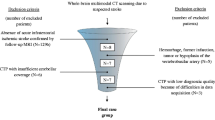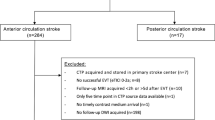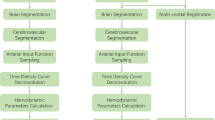Abstract
Introduction
The aim of this study was to examine reliability and reproducibility of volumetric perfusion deficit assessment in patients with acute ischemic stroke who underwent recently introduced whole-brain CT perfusion (WB-CTP).
Methods
Twenty-five consecutive patients underwent 128-row WB-CTP with extended scan coverage of 100 mm in the z-axis using adaptive spiral scanning technique. Volumetric analysis of cerebral blood volume (CBV), cerebral blood flow (CBF), mean transit time (MTT), time to peak (TTP), and time to drain (TTD) was performed twice by two blinded and experienced readers using OsiriX V.4.0 imaging software. Interreader agreement and intrareader agreement were assessed by intraclass correlation coefficients (ICCs) and Bland–Altman Analysis.
Results
Interreader agreement was highest for TTD (ICC 0.982), followed by MTT (0.976), CBF (0.955), CBV (0.933), and TTP (0.865). Intrareader agreement was also highest for TTD (ICC 0.993), followed by MTT (0.988), CBF (0.981), CBV (9.953), and TTP (0.927). The perfusion deficits showed the highest absolute volumes in the time-related parametric maps TTD (mean volume 121.4 ml), TTP (120.0 ml), and MTT (112.6 ml) and did not differ significantly within this group (each with p > 0.05). In comparison to time-related maps, the mean CBF perfusion deficit volume was significantly smaller (92.1 ml, each with p < 0.05). The mean CBV lesion size was 23.4 ml.
Conclusions
Volumetric assessment in WB-CTP is reliable and reproducible. It might serve for a more accurate assessment of stroke outcome prognosis and definition of flow-volume mismatch. Time to drain showed the highest agreement and therefore might be an interesting parameter to define tissue at risk.



Similar content being viewed by others

References
Palm F, Urbanek C, Wolf J, Buggle F, Kleemann T, Hennerici MG, Inselmann G, Hagar M, Safer A, Becher H et al (2012) Etiology, risk factors and sex differences in ischemic stroke in the Ludwigshafen Stroke Study, a population-based stroke registry. Cerebrovasc Dis 33(1):69–75
Hacke W, Kaste M, Bluhmki E, Brozman M, Davalos A, Guidetti D, Larrue V, Lees KR, Medeghri Z, Machnig T et al (2008) Thrombolysis with alteplase 3 to 4.5 hours after acute ischemic stroke. N Engl J Med 359(13):1317–1329
Shih LC, Saver JL, Alger JR, Starkman S, Leary MC, Vinuela F, Duckwiler G, Gobin YP, Jahan R, Villablanca JP et al (2003) Perfusion-weighted magnetic resonance imaging thresholds identifying core, irreversibly infarcted tissue. Stroke J Cereb Circ 34(6):1425–1430
Lee JY, Kim SH, Lee MS, Park SH, Lee SS (2008) Prediction of clinical outcome with baseline and 24-hour perfusion CT in acute middle cerebral artery territory ischemic stroke treated with intravenous recanalization therapy. Neuroradiology 50(5):391–396
Barber PA, Demchuk AM, Zhang J, Buchan AM (2000) Validity and reliability of a quantitative computed tomography score in predicting outcome of hyperacute stroke before thrombolytic therapy. ASPECTS Study Group. Alberta Stroke Programme Early CT Score. Lancet 355(9216):1670–1674
Schaefer PW, Barak ER, Kamalian S, Gharai LR, Schwamm L, Gonzalez RG, Lev MH (2008) Quantitative assessment of core/penumbra mismatch in acute stroke: CT and MR perfusion imaging are strongly correlated when sufficient brain volume is imaged. Stroke J Cereb Circ 39(11):2986–2992
Koenig M, Kraus M, Theek C, Klotz E, Gehlen W, Heuser L (2001) Quantitative assessment of the ischemic brain by means of perfusion-related parameters derived from perfusion CT. Stroke J Cereb Circ 32(2):431–437
Morhard D, Wirth CD, Fesl G, Schmidt C, Reiser MF, Becker CR, Ertl-Wagner B (2010) Advantages of extended brain perfusion computed tomography: 9.6 cm coverage with time resolved computed tomography–angiography in comparison to standard stroke-computed tomography. Investig Radiol 45(7):363–369
Diekmann S, Siebert E, Juran R, Roll M, Deeg W, Bauknecht HC, Diekmann F, Klingebiel R, Bohner G (2010) Dose exposure of patients undergoing comprehensive stroke imaging by multidetector-row CT: comparison of 320-detector row and 64-detector row CT scanners. AJNR Am J Neuroradiol 31(6):1003–1009
Murayama K, Katada K, Nakane M, Toyama H, Anno H, Hayakawa M, Ruiz DS, Murphy KJ (2009) Whole-brain perfusion CT performed with a prototype 256-detector row CT system: initial experience. Radiology 250(1):202–211
Bland JM, Altman DG (1986) Statistical methods for assessing agreement between two methods of clinical measurement. Lancet 1(8476):307–310
Wittkamp G, Buerke B, Dziewas R, Ditt H, Seidensticker P, Heindel W, Kloska SP (2010) Whole brain perfused blood volume CT: visualization of infarcted tissue compared to quantitative perfusion CT. Acad Radiol 17(4):427–432
Kloska SP, Fischer T, Nabavi DG, Dittrich R, Ditt H, Klotz E, Fischbach R, Ringelstein EB, Heindel W (2007) Color-coded perfused blood volume imaging using multidetector CT: initial results of whole-brain perfusion analysis in acute cerebral ischemia. Eur Radiol 17(9):2352–2358
Lin K, Rapalino O, Lee B, Do KG, Sussmann AR, Law M, Pramanik BK (2009) Correlation of volumetric mismatch and mismatch of Alberta Stroke Program Early CT Scores on CT perfusion maps. Neuroradiology 51(1):17–23
Hesselmann V, Niederstadt T, Dziewas R, Ritter M, Kemmling A, Maintz D, Koehler M, Seifarth H, Jacobs AH, Ringelstein EB et al (2012) Reperfusion by combined thrombolysis and mechanical thrombectomy in acute stroke: effect of collateralization, mismatch, and time to and grade of recanalization on clinical and tissue outcome. AJNR Am J Neuroradiol 33(2):336–342
Grotta JC, Chiu D, Lu M, Patel S, Levine SR, Tilley BC, Brott TG, Haley EC Jr, Lyden PD, Kothari R et al (1999) Agreement and variability in the interpretation of early CT changes in stroke patients qualifying for intravenous rtPA therapy. Stroke J Cereb Circ 30(8):1528–1533
Pexman JH, Barber PA, Hill MD, Sevick RJ, Demchuk AM, Hudon ME, Hu WY, Buchan AM (2001) Use of the Alberta Stroke Program Early CT Score (ASPECTS) for assessing CT scans in patients with acute stroke. AJNR Am J Neuroradiol 22(8):1534–1542
Parsons MW, Pepper EM, Chan V, Siddique S, Rajaratnam S, Bateman GA, Levi CR (2005) Perfusion computed tomography: prediction of final infarct extent and stroke outcome. Ann Neurol 58(5):672–679
Diehm N, Kickuth R, Gahl B, Do DD, Schmidli J, Rattunde H, Baumgartner I, Dick F (2007) Intraobserver and interobserver variability of 64-row computed tomography abdominal aortic aneurysm neck measurements. J Vascular Surg Off Publ Soc Vascular Surg Intern Soc Cardiovas Surg North Am Chapter 45(2):263–268
Wintermark M, Flanders AE, Velthuis B, Meuli R, van Leeuwen M, Goldsher D, Pineda C, Serena J, van der Schaaf I, Waaijer A et al (2006) Perfusion-CT assessment of infarct core and penumbra: receiver operating characteristic curve analysis in 130 patients suspected of acute hemispheric stroke. Stroke J Cereb Circ 37(4):979–985
Wintermark M, Fischbein NJ, Smith WS, Ko NU, Quist M, Dillon WP (2005) Accuracy of dynamic perfusion CT with deconvolution in detecting acute hemispheric stroke. AJNR Am J Neuroradiol 26(1):104–112
Abels B, Klotz E, Tomandl BF, Kloska SP, Lell MM (2010) Perfusion CT in acute ischemic stroke: a qualitative and quantitative comparison of deconvolution and maximum slope approach. AJNR Am J Neuroradiol 31(9):1690–1698
Abels B, Klotz E, Tomandl BF, Villablanca JP, Kloska SP, Lell MM (2011) CT perfusion in acute ischemic stroke: a comparison of 2-second and 1-second temporal resolution. AJNR Am J Neuroradiol 32(9):1632–1639
Cohnen M, Wittsack HJ, Assadi S, Muskalla K, Ringelstein A, Poll LW, Saleh A, Modder U (2006) Radiation exposure of patients in comprehensive computed tomography of the head in acute stroke. AJNR Am J Neuroradiol 27(8):1741–1745
Conflict of interest
We declare that we have no conflict of interest.
Author information
Authors and Affiliations
Corresponding author
Additional information
KMT and WHS contributed equally to this study and the manuscript.
Rights and permissions
About this article
Cite this article
Thierfelder, K.M., Sommer, W.H., Baumann, A.B. et al. Whole-brain CT perfusion: reliability and reproducibility of volumetric perfusion deficit assessment in patients with acute ischemic stroke. Neuroradiology 55, 827–835 (2013). https://doi.org/10.1007/s00234-013-1179-0
Received:
Accepted:
Published:
Issue Date:
DOI: https://doi.org/10.1007/s00234-013-1179-0



